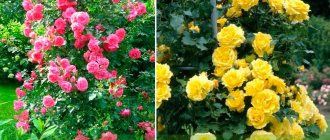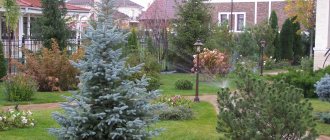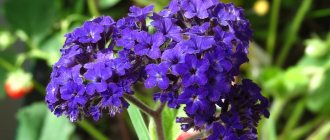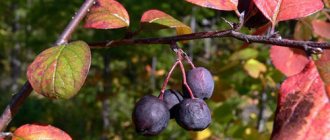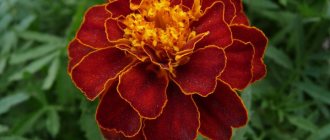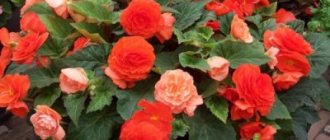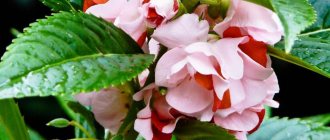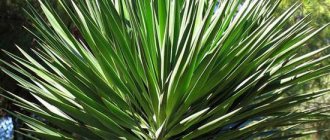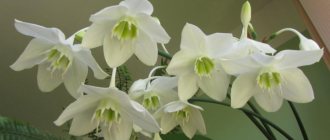Thuja: the amazing tree of life
All over the world, the thuja tree is highly valued for its decorative value. This coniferous evergreen species is beautiful in both winter and summer. Under favorable conditions in nature, it can reach a height of 20-30 m, and the trunk can reach 180 cm in diameter. In culture, thuja is much lower. When young, the tree is especially graceful. Its crown is narrowly pyramidal; later it becomes ovoid, but does not lose its decorative appearance. For this reason, thuja is called the “cypress of the North” in contrast to the real cypress that grows in the south. It’s hard to even imagine that this fluffy tree, already familiar in parks and gardens, is not found in the wild nature of our region. Thuja came to us from the southeastern part of Canada and the northern part of the United States several centuries ago. Under natural conditions, in its homeland, thuja grows up to 20 meters, but in our latitudes it is more common to see it about 10 meters high.
Flowerbed with thujas.
If you need to choose a plant for a hedge, a seating area, or to decorate a porch or terrace, choose a thuja, especially when the area has marshy and peaty soils that are unsuitable for most fruit and berry crops.
The best plants for creating hedges that protect from dust (read more)
Sowing seedlings
When collecting seeds for seedlings, it is necessary to remember the importance of time - preference is given to ripened seeds collected at the end of August rather than fully ripened ones taken in the autumn. Because the germination percentage of the first collection condition is higher.
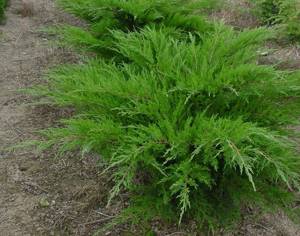
The seeds cannot be stored; they are planted immediately, but you should know that the dense shell of the seed delays its germination for up to three years.

You can plant juniper seeds in the forest, marking the location; this is done to closely replicate the conditions of natural growth. When replanting, dig up a sufficiently voluminous lump of soil, preserving the surface layer of humus.
leave a comment
Click to cancel reply.
Description of the thuja tree
The thuja tree is a coniferous plant from the Cypress family, which can be a tree or shrub with flat shoots. There are five types of thuja:
- Western thuja , or life tree (Thuja occidentalis);
- Thuja Sichuan , or Chinese thuja (Thuja sutchuenensis);
- Korean thuja (Thuja koraiensis);
- Japanese thuja , or Standish thuja (Thuja standishii);
- Thuja folded , or giant Thuja (Thuja plicata).
All types of thuja are evergreen with a dense crown, and the needles tolerate cold and air pollution well. Therefore, they are ideal for improving cities in temperate latitudes. Thuja wood contains aromatic essential oils that give the plant a pleasant smell. In our cold latitudes, various varieties of western thuja grow well and withstand winters.
Thuja occidentalis is an evergreen coniferous tree from the Cypress family (Cupressaceae), genus Thuja, naturally found in the eastern regions of North America.
Thanks to the large number of highly decorative artificially bred forms, winter hardiness, durability and resistance to urban conditions, thuja occidentalis is very widespread in ornamental gardening across all continents in many climatic zones.
Thuja shoots are covered with scale-like, and in transitional forms - with needle-shaped needles, which are bright green in spring, dark green in summer, and brown-green in winter. The needles fall off after 4-5 years along with the branches (twig fall).

Thuja occidentalis “Pyramidal”.
An interesting biological feature of the thuja is “blooming” or, more correctly, dusting. Its flowers are called spikelets. Female spikelets are yellow-green, kidney-shaped, located mainly in the upper part of the crown. The male ones are brownish-yellow, rounded, and you will find them at the bottom of the tree. In the central zone of the European part of Russia, the thuja occidentalis gathers dust in the spring in April-May, before the shoots begin to grow. The duration of dusting, depending on the weather, is 6-12 days. Then oval bumps form. They ripen annually within 160-180 days, but abundant harvests occur after 2-3 years. When ripe, the scales open slightly and flat seeds with narrow wings fly out. The weight of 1000 pieces is 1.4-1.8 g, germination lasts no more than 2 years.
1-1.5 weeks after pollination, shoots begin to grow. The annual growth is 10-15 cm. The thuja has a shallow root system, so do not forget to shake off wet snow from the tree in winter so that it does not fall or break.
For decorative design of plots, we often use western thuja (Thuja occidentalis L.). It is native to the coniferous and coniferous-deciduous forests of North America, stretching from Canada to North Carolina. Under natural conditions, thuja forms dense thickets mainly in swamps and in places with close groundwater; it is also found on the rocky banks of mountain rivers and in valleys. Prefers moist, fresh, clay soils in mixed forests. Such a detailed acquaintance with the habitat conditions will probably help amateur gardeners to better select soils, planting sites and “companion” plants for thuja.
Thuja occidentalis lives for more than a hundred years and therefore can delight more than one generation of people. And even after the death of a tree, a good owner will find a use for its wood. In thuja it is yellowish-brown, with narrow light sapwood, fragrant, very light, soft, resistant to rot. Pine needles are also valued, as they contain a lot of essential oil, which is used in perfumery and medicine. Finally, it is a phytoncidal plant that can heal the surrounding air.

Tui.

Thuja plicata “Grune Kugel”.
Thuja occidentalis is suitable for most areas of the former Soviet Union. It is winter-hardy and wind-resistant, tolerates excessive soil moisture and at the same time is quite drought-resistant, light-loving and at the same time shade-tolerant, tolerates shearing well and is renewed after cutting, and is not too demanding on soil fertility. The tree can be planted close to the house, as it is safer in case of fire than other conifers, such as fir. This is due to the fact that thuja has denser wood and a lot of moisture in the needles.
Haircut and trimming
As a rule, thuja is not cut during the first two years. This allows the plant to develop a strong root system, and the grower to determine the condition and needs of the plant.
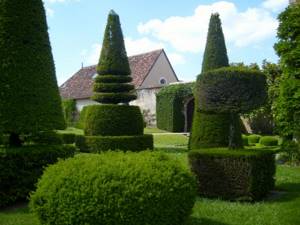
When pruning thuja, you must adhere to the following rules:
1. The first pruning is done in April, then throughout the warm season the shape of the crown is formed and adjusted.
2. Pruning is done in dry weather.
3. Before cutting, remove dry parts and, if necessary, thin out the bush.
4. To maintain its shape consistently, it is recommended to cut off all annual shoots.
5. To grow the bush in width, the upper part of the plant is cut off.
Planting thuja
If you decide to plant a thuja in the garden, then choose an area where the sun will not be all day long. Due to constant direct sunlight, the plant may become dehydrated or get sick from frost in winter. The soil is best suited to be turf, with the addition of peat and sand. Without any problems, thuja will grow in any other soil - swamp, clay, sandy loam.
When planting thujas in groups, it is necessary to maintain the correct distance between trees; it can range from 1 to 5 meters, namely when planting a single-row hedge of 1 m, with a double-row hedge - up to 2 m, and when planting large species of thuja in an alley up to 5 m. We should not forget that trees will grow not only in height, but also in width. Planting depth is 60-80 cm. It is advisable to plant thuja in the spring, although at any time of the year thuja tolerates planting well if the gardener does the right thing.
Thuja is grown outdoors: in open ground or in a pot, in single and group plantings, in hedges, shelterbelts, and, if possible, in a cool and humid microclimate. Usually these plants are planted in a permanent place in November or March. They prefer deep and slightly moist but well-drained soils.
For hedges, thuja is planted, maintaining a distance of 60-70 centimeters between plants. When growing thuja in pots or flower beds, use a substrate of peat and fertile soil with the addition of organic fertilizers in the amount of 30-50 grams per bucket of soil. From the second year of life, liquid fertilizing with mineral fertilizers is practiced.

Living wall made of thuja.
Preparing thuja for winter
Young seedlings require additional shelter in the first years of growth. To insulate thuja, non-woven spunbond or thick greenhouse film is used. The roots are protected with fallen leaves, which are removed in the spring.

Mature bushes are protected from snow and winds, the branches are pulled towards the trunk. As it accumulates, snow deposits are removed to prevent mold from appearing.
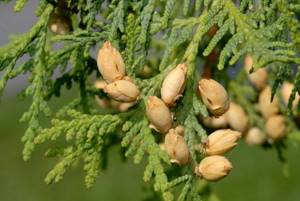
Growing thuja
Thuja is easy to grow from seeds; it is accessible to every novice gardener. They should be collected from the mother plants in September-December. Carefully cut off the cones and spread the seeds to dry in a thin layer on a table in a cool room or on the terrace, where the temperature is no higher than 6-7°C. As soon as the scales of the cones dry, you should remove the seeds from them and sift through a sieve with cells measuring 6x6 mm. Then put them in gauze bags and store them in a cool room until snow appears. As soon as it falls, the bags need to be laid out on the ground and covered with a 30 cm layer of snow. In the spring, the seeds are sown in rows on ridges (the distance between the rows is 10 cm), planted to a depth of 0.5 cm. The seeding rate is about 5 g of seeds per 1 m² . The crops are lightly sprinkled with pine sawdust and watered regularly but moderately. Germination rate is usually about 90%.
Seedlings are protected from direct sunlight with shields. In the first year they grow to 4-6 cm, the next to 10-20 cm, and in the 3rd year - from 25 to 40 cm. In dry times, the soil under the plants is mulched with peat or sawdust. At the age of three they are picked, and in the 5th year they are planted in a permanent place, preferably in the spring. Feeding with a weak solution of slurry has a beneficial effect on the growth of seedlings. However, nitrogen fertilizers should be used with caution.
Thuja occidentalis and its forms are also propagated by green and lignified cuttings; decorative forms can be grafted onto savages.

Thuja occidentalis “Hoseri”.

Thuja occidentalis “Emerald”.
Thuja can grow both in a sunny place and in partial shade, but in full shade its crown thins out. Any soil is suitable: peaty, clayey, dry sandy loam, the main thing is that it is well permeable. On heavy damp soils, drainage is made with a layer of 15–20 cm; in swamps, pipes are laid in trenches.
When purchasing and replanting plants, make sure that the earthen ball around the roots of the thuja is preserved. Young plants tolerate transplantation more easily. Planting holes should be 60–80 cm deep, depending on the size of the earth ball, the height and diameter of the plant crown. They are covered with a mixture of turf or leaf soil, peat and sand (2:1:1) with the addition (at planting) of 50–100 g of nitroammophoska for each adult plant. The root collar should be at soil level.
When planting plants in groups, maintain a distance of 3 to 5 m between them, focusing on the size of future trees. In alleys, thujas are usually planted 4 meters from one another.
Feed the plants in the spring. Typically, complex fertilizers are used for this, for example, Kemiru-universal, at a rate of 50–60 g/m². If full mineral fertilizer was applied during planting, the first fertilizing is carried out only after two years.
The lush needles of the thuja evaporate a lot of moisture, so the soil should not be allowed to dry out, including in the fall. In the first month after planting, it is watered once a week (10–50 liters per seedling, depending on its size), in addition, the crown must be irrigated. Thanks to sprinkling, the dust is not simply washed away: the stomata of the leaves open, it becomes easier for the plant to breathe and, accordingly, all physiological processes proceed more intensely.
During the growing season, the soil is loosened to a depth of 8–10 cm (thuja has a superficial root system). It is advisable to mulch the tree trunk circles - with peat, wood chips, bark, compost. This will protect the roots from overheating and drying out in the summer and from rapid freezing in the winter.
For the first three to four years, plants are covered to avoid winter and spring sunburn. Adult thujas are quite winter-hardy. However, it is advisable to lightly tie the branches of tall trees with twine so that their crowns do not break under the weight of wet snow.
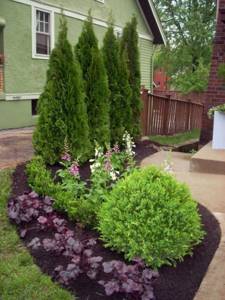
Tui.
Watering mode
For good growth and development of thuja, sufficient watering is necessary. The watering regime involves adding 10 liters of water to the root part once a week. In dry weather - 2-3 times a week.
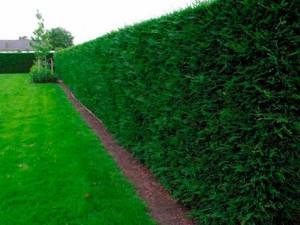
Thuja also needs sufficient sprinkling - irrigation of the crown. You can irrigate thuja 1-2 times a day.
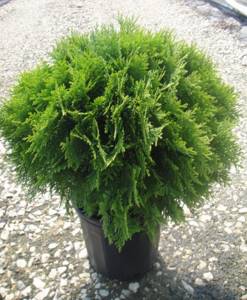
Reproduction of thuja
Thuja can be propagated by seeds and vegetatively. Seed propagation is acceptable only for thuja species, but not for forms and varieties (decorative qualities will be lost). In addition, this is a labor-intensive and lengthy process: it will take three to five years to grow a seedling. The seeds must be freshly collected. They are subjected to natural stratification, leaving them under the snow in the fall.
In the spring, they are sown on ridges, deepened to just 0.5 cm, and lightly sprinkled with pine sawdust. Thuja seedlings are protected from the sun with shields, and the soil is kept loose and moist. Feed with a weak solution of slurry (1:20).
Most often, western thuja and its forms are propagated by lignified cuttings (using 2–3-year-old shoots 25–40 cm long) and semi-lignified ones (current year’s growth 10–20 cm long, cut in June). The cuttings are cut off so that a small piece of old wood remains at the base of the shoot - the “heel”. In this case, the cuttings take root better.
They are treated with a heteroauxin solution and placed in a greenhouse. The soil is prepared from a mixture of river sand with peat and turf soil (in a ratio of 1:1:1), disinfected with potassium permanganate. The cutting depth is from 1.5 to 2.5 cm.
Cuttings begin before the buds begin to swell, at the end of April - the first ten days of May, and also after the end of shoot growth, at the end of June. 2-3-year-old branches 25-40 cm long are cut from mother plants in any part of the crown. Cuttings (10-20 cm) are cut from them with a heel - a piece of old bark. They are treated for 12 hours with an aqueous solution of heteroauxin (20 mg/l) and planted in a nursery to a depth of 1.5 to 2.5 cm. Sod soil is poured into the nursery, and on top is a layer of river sand with peat (1:1). Before planting the cuttings, the ground is bayoneted, disinfected with a solution of potassium permanganate and spilled with water.
One of the most important conditions for rooting cuttings is maintaining high air humidity, but without waterlogging the substrate. To do this, use sprinklers with nozzles that create artificial fog, or cover the cuttings with film, after watering them from a watering can with a fine strainer. At an air temperature of 25°, the artificial fog installation is turned on 6 times daily with a watering duration of 0.5 to 1 minute (at temperatures up to 20° - 4 times). In hot sunny weather, the film is whitened with lime mortar. Weeds are periodically weeded and measures are taken to combat pests and diseases.
As soon as the cuttings take root, they begin to harden off - reduce watering and ventilate, opening the nursery for a while. For the winter, around November, they are covered with leaves, sawdust or spruce branches, and when frosts reach minus 5-7°, also with film. In some areas (for example, in the Chernozem zone and further south), thuja cuttings overwinter without shelter, under natural snow cover. In the spring, the insulation is removed, the plants are straightened after winter by pressing them into the ground, and weeded.
In a greenhouse, it is very important to maintain high air humidity without overmoistening the substrate, so spraying is more desirable than watering. Rooted cuttings are ventilated and hardened. In November, they are insulated with leaves, sawdust or spruce branches, and when frost sets in (-5..-7 °C) they are additionally covered with film.
Diseases and pests of thuja
Diseases are caused by dangerous pathogens: fungi of the genus Fusarium, Cytospora, Foma and others. They affect crowns, shoots, and needles. Schütte thuja brown only damages needles. To combat fungal diseases, Bordeaux mixture or carticide is used. Trees are treated starting in spring, at intervals of two weeks, until they are fully recovered.
The most dangerous pests are the thuja aphid and the thuja false scale insect. Needles damaged by aphids turn yellow and fall off. To get rid of it, the plant is sprayed several times with karbofos, rogor or decis. No less harm is caused by the thuja false scale insect, which is found on needles and twigs. Before the buds open, the plants are sprayed with karbofos, and at the end of June they are treated twice with actellik, rogor or chlorophos (with an interval of one and a half to two weeks).
Thuja tree in the garden
When to talk about conifers, no matter in winter. Most of them are increasingly used by landscape designers when arranging their garden plots. After all, this is a polymorphic plant that has more than 120 decorative forms, which differ in color, shape of needles and branches, and growth pattern. Therefore, you can choose a thuja with a pyramidal, narrow-columnar, spherical or ovoid crown shape, and with the help of pruning you can give the plants curly shapes.
One of the most popular plants is the thuja occidentalis, although there are 6 species in total. The name of the plant comes from the Greek word thuo, which means “to sacrifice, to smoke.” Indeed, when its branches burn, a very pleasant smell is released, reminiscent of the aromas used in sacrifice ceremonies. And all thanks to the fact that thuja leaves contain a lot of essential oils with a strong camphor odor, which are valuable medicinal raw materials for the perfume industry. By the way, in the plant’s homeland, North America, the aborigines made canoes from thuja, and made medicinal teas from the bark.

Thuja.

Thuja.
This is an unpretentious frost- and drought-resistant plant. It tolerates replanting well (younger plants are better), especially in spring. Any soil is suitable for planting, it is only important that it is breathable. Thuja occidentalis is easy to trim, however, the shoots should be cut back by no more than a third. It grows slowly. Gas-resistant, so it easily fits in large cities. On too dry soils and in the shade, the plant loses its decorative effect: the crown becomes thinner and many cones form. But it can also grow in partial shade, however, it feels better in sunny places.
The thuja genus belongs to the cypress family. These are trees or bushes with flat shoots and scale-like needles pressed against them. The cones are small, 0.8-1 cm, they ripen in early autumn. The hole for planting needs to be dug 2-3 times larger than the root ball. However, when planting a container plant, it is important not to deepen or raise the root collar above the soil level, but to place it at its level. Under no circumstances should the lower shoots touch the ground. The tree trunk circles need to be mulched - with peat, bark, compost, leaf humus, in a layer up to 5 cm thick. This will protect the plant from drying out in summer and freezing in winter.
If you want to make life easier for a young plant, do not forget to water it once a week during the first month after planting. Depending on the size of the trees, from 10 to 50 liters per seedling is needed. At the same time, it is advisable to irrigate the crowns - thuja really likes spraying.
Western thuja is used in single and group plantings, creating hedges and alleys. It is important not to overload the area with thujas. Do not also forget that thujas are quite tall plants, so they should not be placed near other trees and rooms (no closer than 3 m). When planting in groups, the distance between plants is also maintained from 2 to 5 m. Miniature plants are planted in borders, rock gardens, and along paths. The value of the plant lies in the fact that it does not lose its decorative value throughout the year. Florists love to use cut branches of pine needles.
Thuja is propagated both vegetatively and from seeds. It is advisable to use them fresh, collected in the fall; moreover, the seeds require stratification. When stored in a warm place, germination is lost.
Preparations based on thuja stimulate the central and immune nervous systems, and also cardiac activity. Known for their antiseptic, choleretic, diaphoretic, expectorant, anti-inflammatory and hemostatic effects. Decoctions and infusions of fresh branches strengthen hair.
But we must remember that in large quantities, thuja essential oil acts as a poison. Thuja preparations are contraindicated during pregnancy, epilepsy and individual intolerance.
Single thuja plants look good against the background of a lawn or other tree species. You can use them to form an intricate group and hedge, create an alley or a small grove. Everything will look picturesque. Thuja will perfectly decorate your garden! This beautiful coniferous tree also has a very pleasant smell!
The best coniferous plants with yellow needles: juniper, thuja, spruce and pine (read more)
Top dressing
You can achieve rapid growth and improve the decorative qualities of thuja with the help of timely fertilizer. It is recommended to feed thuja 1-2 times per season.

To sufficiently retain moisture, protect against weeds and improve fertility, the tree trunk circle is mulched with compost or sawdust.

